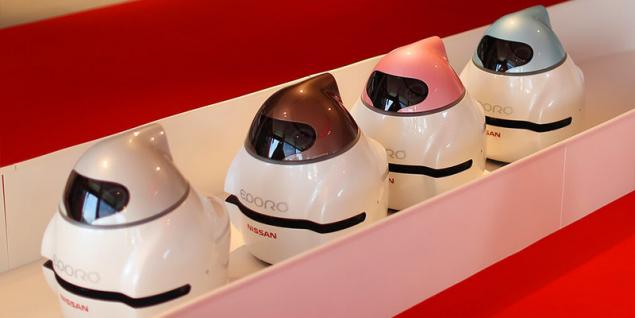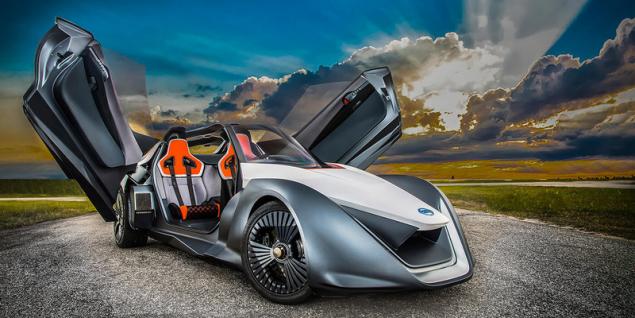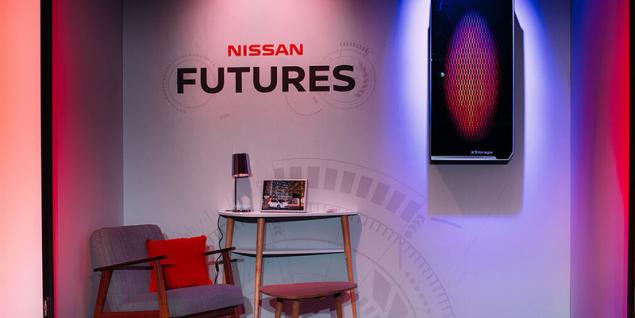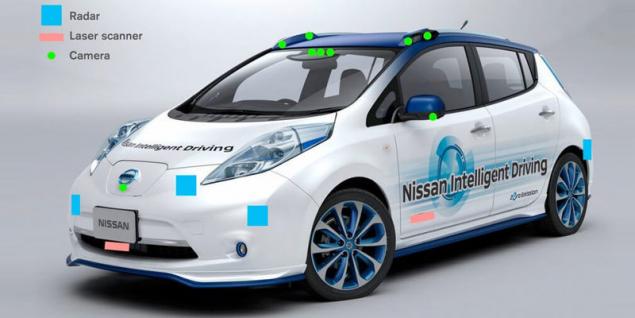Touches of the future: it plans to develop a Nissan
 Bashny.Net
Bashny.Net
You can endlessly look at fire, water and mini-Nissan Eporo robots. Curious creating, twisting multi-colored big-eyed heads, slowly moving along the track laid in the middle of the foyer of the Nissan office in Spain. I can not figure out who you look like cartoony pieces. Watching Eporo Japanese explains: "It's fish".





It turns out that the Eporo – media technology that allows the car to move in the flow, simulating a behavioral model of a school of fish: they do not touch each other and bend around obstacles. Put in the way of "fish" hand. Eporo slow, unhappy glows red, the other for him. Take my hand and Robo-flock, sumigaw green backlight, continues to "float". And so it looks like the future.
Going on a Spanish Futures event, Nissan – workshop on the theme of corporate prospects – I was expecting to see cars. Not school small Eporo, and something of the largest four-wheeled ideas. For example, a triple faceted electric car Bladeglider. Or fancy spitalsky pickup Navara EnGuard Concept with its drones-spies in the back, or aggressive hybrid compact crossover Gripz. Finally, one of the most advanced prototype – electric same IDS, which is tipped as a successor model Leaf. But no, nothing like that in Spain brought. However, this does not mean that Nissan is not planning to release new models in the coming years. Nissanusa talking about the term in a broad sense and talk about the steps made in this direction.

The action starts with a demonstration of photos of residential interiors, where on the walls hang some rectangular devices. They are called xStorage – joint development of Nissan and Eaton. What's the point? The device xStorage is a compact storage of electricity, which are based to a used battery from a Nissan Leaf.
With xStorage, the Europeans will be able to buy electricity at the best night tariffs and accumulate for later use in the busiest hours, and save energy from solar and other renewable sources. And not only to store electricity for its own needs (including emergency supply), but also to sell some stock back in. xStorage became available to Europeans from December at a price of 3,500 euros, offered by the installation capacity of 3.5 kW. System at 6 kW will cost 3900 euros, and collected from new batteries cost from 5,000 euros, but have a greater capacity and extended up to 10 years manufacturer's warranty. The promised savings on electricity bills – 600 euros per year.

On the screen there is a photo of the huge stadium. Nissan and Eaton announced the conclusion of a major agreement with Amsterdam Arena – the home arena of football club "the Ajax" – the integration of the system xStorage Building connected to the sports complex. Today xStorage Building is Europe's largest system of accumulation of electricity for commercial use and consists of 280 batteries from the Nissan Leaf, received a second life. And now xStorage Building provides efficient and stable power supply of the stadium, even in the case of emergencies in the urban energy supply. For those who understand that Nissan cars: it is unequivocal corporate success – a bright and profitable future here it is, partly due. Batteries should last you the whole story xStorage: right now Leaf is best selling electric car in the world.
On the basis of the Nissan Leaf, the company now hones a set of technologies Nissan Intelligent Driving, which devoted the lion's share of the seminar. NID – based global strategy Nissan Intelligent Mobility, it reflects the key decisions of the company regarding how cars should be driven, managed, and integrated in society. This, in turn, on Autonomous driving: systems to support "independent swimming", called ProPilot.
It all started with the sample Leaf, which is able automatically to Park and to move independently in a traffic jam. Then nissanusa announced system of automatic shift from lane to lane and overtaking of the auto. The debut of the car with full autonomy declared for 2020 – and, most likely, something will go offline serial on motives of the above-mentioned concept IDS. And after 30 years, according to nissanusa, cars with Autonomous control will bring the European economy as much as 17 trillion euros.

But as they say, much remains to be done. For example, to understand how European society as a whole are willing to cars with autopilots. Here comes to the aid of sociology. And now Nissan reports on the outcome of a strong independent research Freeing the Road, prepared by the research center Policy Network for the analysis of social and economic impact of vehicles with Autonomous control. In total, it polled about 6,000 people in the UK, France, Germany, Spain, Italy and Norway.
The study showed that the majority of respondents believe vehicles with Autonomous control positive milestone progress and predict a large impact of technology on the world as a whole. The participants hope to reduce the number of incidents and tense moments on the road caused by human errors and recklessness and drunkenness. In General, the participants of Poros sure that the piloting will help to reduce the overall level of traffic stress. And autopilots seen a great solution for vulnerable population: people with disabilities, the elderly and the visually impaired.
The survey participants appreciated the opportunity to free up time now to drive the car. Four out of five respondents would like the time to do something else. More than half admitted that driving distracted by finding the correct radio station or something to eat. And they want even more: to view during traffic news, read books, work or simply to sleep.
Of course, like any new technology raises concerns. Almost half of respondents cited the main disadvantage of Autonomous control the risk of malfunction, a failure in the system, especially when the complete impossibility of driving yourself. Sympathetic Europeans worried that, with the introduction of autopilots, many professional drivers will lose their jobs. But the report also contains recommendations on what key steps need to be taken to the various governments and other regulatory authorities to overcome technological and social barriers standing in the way of vehicles with Autonomous control. In particular, how to ensure that infrastructure is not failed, and the unemployed drivers were engaged in it, after re-training and come out to rallies.

Yes, the sample survey is small, but we assume that society is ready to accept the autopilot. The question of the readiness of the systems themselves auto-pilot. One of the reports we read scientist-anthropologist Melissa Cepkin, which takes an active part in the development of systems. According to Melissa, now the autopilot can accurately work only in a perfect world, where all the car's surroundings orderly and operates strictly according to the rules. Task Zetkin to study behavioral patterns in a variety of situations and train system all the features of the reality, where pedestrians can take unpredictable actions, and the drivers of neighboring cars to dramatically change the solution. In the electronic brain of the car with the auto-pilot system, you must download a lot of options of reactions to changes in the environment.
"Imagine that you started to change and suddenly you are overtaking a vehicle driving in an adjacent lane. As your car will give important information about what you approaching another vehicle, and how he would react to the situation? Or imagine turning on a city street and the pedestrian, suddenly appeared on the roadway. What this should tell you your car? In this situation, you need to be informed and in any case not scared," she said. One of the found solutions simplify communication demonstrates the concept IDS. It communicates with pedestrian messages that are displayed on the lower edge of the windshield. "I will go after you," shows, for example, IDS, braking at the pedestrian crossing.
Looking for answers to the questions and the Deputy General Manager of Department of development of the technologies of Autonomous control Nissan Takashi Sunda. "The driving style is very individual. It is influenced by both cultural and personal characteristics. Europeans used to go strictly by the rules. And in China, for example, the traffic is more chaotic, but for locals it's normal. In Asia, motorcycles are frequently cross the highway, and in the UK drive on the left. That's why you need to consider all the possible scenarios. However, this can be a very difficult task. Drivers who are facing their first Autonomous control, needs to feel comfortable. Everything should be simple and understandable. Change has already begun." published
Source: www.autonews.ru/news/5864aec59a794795b3954762





It turns out that the Eporo – media technology that allows the car to move in the flow, simulating a behavioral model of a school of fish: they do not touch each other and bend around obstacles. Put in the way of "fish" hand. Eporo slow, unhappy glows red, the other for him. Take my hand and Robo-flock, sumigaw green backlight, continues to "float". And so it looks like the future.
Going on a Spanish Futures event, Nissan – workshop on the theme of corporate prospects – I was expecting to see cars. Not school small Eporo, and something of the largest four-wheeled ideas. For example, a triple faceted electric car Bladeglider. Or fancy spitalsky pickup Navara EnGuard Concept with its drones-spies in the back, or aggressive hybrid compact crossover Gripz. Finally, one of the most advanced prototype – electric same IDS, which is tipped as a successor model Leaf. But no, nothing like that in Spain brought. However, this does not mean that Nissan is not planning to release new models in the coming years. Nissanusa talking about the term in a broad sense and talk about the steps made in this direction.

The action starts with a demonstration of photos of residential interiors, where on the walls hang some rectangular devices. They are called xStorage – joint development of Nissan and Eaton. What's the point? The device xStorage is a compact storage of electricity, which are based to a used battery from a Nissan Leaf.
With xStorage, the Europeans will be able to buy electricity at the best night tariffs and accumulate for later use in the busiest hours, and save energy from solar and other renewable sources. And not only to store electricity for its own needs (including emergency supply), but also to sell some stock back in. xStorage became available to Europeans from December at a price of 3,500 euros, offered by the installation capacity of 3.5 kW. System at 6 kW will cost 3900 euros, and collected from new batteries cost from 5,000 euros, but have a greater capacity and extended up to 10 years manufacturer's warranty. The promised savings on electricity bills – 600 euros per year.

On the screen there is a photo of the huge stadium. Nissan and Eaton announced the conclusion of a major agreement with Amsterdam Arena – the home arena of football club "the Ajax" – the integration of the system xStorage Building connected to the sports complex. Today xStorage Building is Europe's largest system of accumulation of electricity for commercial use and consists of 280 batteries from the Nissan Leaf, received a second life. And now xStorage Building provides efficient and stable power supply of the stadium, even in the case of emergencies in the urban energy supply. For those who understand that Nissan cars: it is unequivocal corporate success – a bright and profitable future here it is, partly due. Batteries should last you the whole story xStorage: right now Leaf is best selling electric car in the world.
On the basis of the Nissan Leaf, the company now hones a set of technologies Nissan Intelligent Driving, which devoted the lion's share of the seminar. NID – based global strategy Nissan Intelligent Mobility, it reflects the key decisions of the company regarding how cars should be driven, managed, and integrated in society. This, in turn, on Autonomous driving: systems to support "independent swimming", called ProPilot.
It all started with the sample Leaf, which is able automatically to Park and to move independently in a traffic jam. Then nissanusa announced system of automatic shift from lane to lane and overtaking of the auto. The debut of the car with full autonomy declared for 2020 – and, most likely, something will go offline serial on motives of the above-mentioned concept IDS. And after 30 years, according to nissanusa, cars with Autonomous control will bring the European economy as much as 17 trillion euros.

But as they say, much remains to be done. For example, to understand how European society as a whole are willing to cars with autopilots. Here comes to the aid of sociology. And now Nissan reports on the outcome of a strong independent research Freeing the Road, prepared by the research center Policy Network for the analysis of social and economic impact of vehicles with Autonomous control. In total, it polled about 6,000 people in the UK, France, Germany, Spain, Italy and Norway.
The study showed that the majority of respondents believe vehicles with Autonomous control positive milestone progress and predict a large impact of technology on the world as a whole. The participants hope to reduce the number of incidents and tense moments on the road caused by human errors and recklessness and drunkenness. In General, the participants of Poros sure that the piloting will help to reduce the overall level of traffic stress. And autopilots seen a great solution for vulnerable population: people with disabilities, the elderly and the visually impaired.
The survey participants appreciated the opportunity to free up time now to drive the car. Four out of five respondents would like the time to do something else. More than half admitted that driving distracted by finding the correct radio station or something to eat. And they want even more: to view during traffic news, read books, work or simply to sleep.
Of course, like any new technology raises concerns. Almost half of respondents cited the main disadvantage of Autonomous control the risk of malfunction, a failure in the system, especially when the complete impossibility of driving yourself. Sympathetic Europeans worried that, with the introduction of autopilots, many professional drivers will lose their jobs. But the report also contains recommendations on what key steps need to be taken to the various governments and other regulatory authorities to overcome technological and social barriers standing in the way of vehicles with Autonomous control. In particular, how to ensure that infrastructure is not failed, and the unemployed drivers were engaged in it, after re-training and come out to rallies.

Yes, the sample survey is small, but we assume that society is ready to accept the autopilot. The question of the readiness of the systems themselves auto-pilot. One of the reports we read scientist-anthropologist Melissa Cepkin, which takes an active part in the development of systems. According to Melissa, now the autopilot can accurately work only in a perfect world, where all the car's surroundings orderly and operates strictly according to the rules. Task Zetkin to study behavioral patterns in a variety of situations and train system all the features of the reality, where pedestrians can take unpredictable actions, and the drivers of neighboring cars to dramatically change the solution. In the electronic brain of the car with the auto-pilot system, you must download a lot of options of reactions to changes in the environment.
"Imagine that you started to change and suddenly you are overtaking a vehicle driving in an adjacent lane. As your car will give important information about what you approaching another vehicle, and how he would react to the situation? Or imagine turning on a city street and the pedestrian, suddenly appeared on the roadway. What this should tell you your car? In this situation, you need to be informed and in any case not scared," she said. One of the found solutions simplify communication demonstrates the concept IDS. It communicates with pedestrian messages that are displayed on the lower edge of the windshield. "I will go after you," shows, for example, IDS, braking at the pedestrian crossing.
Looking for answers to the questions and the Deputy General Manager of Department of development of the technologies of Autonomous control Nissan Takashi Sunda. "The driving style is very individual. It is influenced by both cultural and personal characteristics. Europeans used to go strictly by the rules. And in China, for example, the traffic is more chaotic, but for locals it's normal. In Asia, motorcycles are frequently cross the highway, and in the UK drive on the left. That's why you need to consider all the possible scenarios. However, this can be a very difficult task. Drivers who are facing their first Autonomous control, needs to feel comfortable. Everything should be simple and understandable. Change has already begun." published
Source: www.autonews.ru/news/5864aec59a794795b3954762
Tags
See also
The use of micro-robots to perform complex teamwork: a new project with funding DARPA (video)
Our universe is a hologram
Modern electric magnifier with video capability
The 12 secrets of beauty and youth from women from different countries of the world
Nissan Leaf ready for sales in Russia
Toyota vs. Tesla: hydrogen or electricity?
I started the 81st International Motor Show in Geneva

















